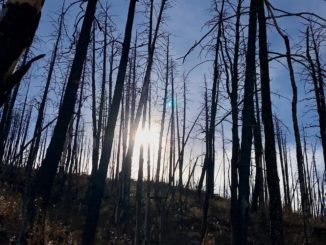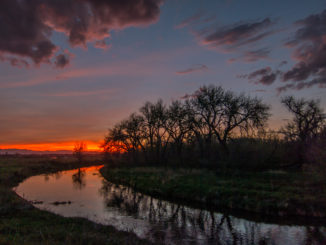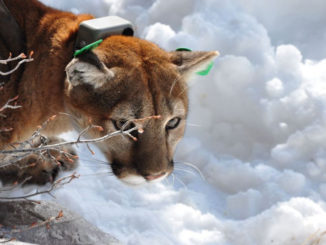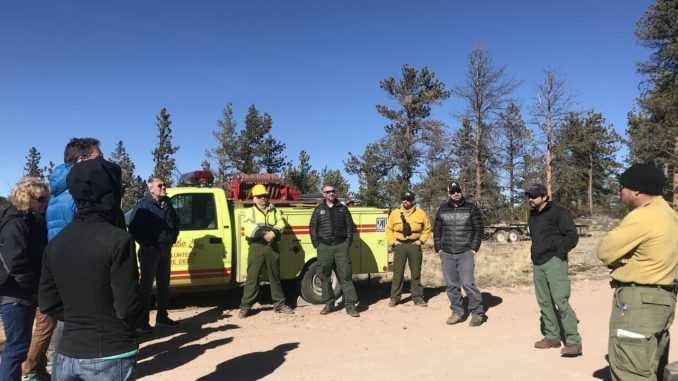
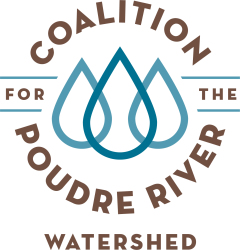
By The Coalition for the Poudre River Watershed
The Poudre headwaters are amazing – there are vast swaths of forests and rivers that we all enjoy for recreation and living. It provides beautiful habitat for plant and animal species and delivers clean drinking water. However, the sheer size and complexity of these forests also poses a challenge for land managers. There are large areas of our forest with lots of fuel, creating a situation where treating those forests with heavy equipment can be expensive and time consuming and we have limited markets to help reduce costs of thinning to a more natural condition. The complex challenges of our forested landscapes are pushing communities interested in forests and wildfires to think more strategically and creatively about finding effective and lasting solutions.
There are several actions we can take to increase our resilience to large and devastating fire but doing so requires us to recognize that fire is an integral part of our landscape. We want to make sure that wildfires can happen without causing long term damage to communities and watersheds while posing less hazards to fire responders. Community groups, forest and fire managers and researchers are realizing that we need to be planning and treating forests at a larger, landscape scales. If we are going to succeed at creating healthier, more resilient forests, our forest management communities will need to reach farther across land ownership boundaries and collaborate deeply with neighboring landowners. Fires don’t care who owns the land and we need to plan with that in mind. Landscape scale restoration can limit those fires that are not safe to manage, pose a very high hazard to communities, degrade the capacity of forests to recover, and increase the potential for undesirable post-fire watershed impacts.
We are fortunate that in our area, there are several entities that are working towards this kind of planned coordination. One effort to increase scale and ensure treatments are located strategically involves a collaborative effort between the US Forest Service, local fire departments and first responders, and researchers at Rocky Mountain Research Station Colorado State University. This effort involves combining expert firefighter knowledge on forest conditions and potential fuel breaks (roads, ridgelines, old fire scars, etc.) with advanced spatial analysis. This group is attempting to plan at the scale appropriate for managing large wildfires. By identifying potential control lines with the highest likelihood of success they are front loading much of planning associated with managing wildfires. These potential control lines are connected throughout the landscape which then allows them to assess values at risk such as homes and water infrastructure, and ecological conditions within each compartment, as well as come up with customized response strategies for each area.
This new strategy will allow land managers and firefighters to better communicate with communities and stakeholders as to where to implement mechanical treatments and prescribed fire before a wildfire occurs, and also help them determine where to construct fire line and conduct burnout operations during a fire. The idea of using these “boxes” to manage undesirable fires or those difficult to suppress is intuitive for firefighters in Northern Colorado. This new effort now helps firefighters develop those response plans spatially and collaboratively to facilitate buy-in and communication with stakeholders and communities. Stakeholders and communities now have a seat at the table and opportunity to help set appropriate ecological and social objectives. Doing so allows firefighters on the ground more time to develop effective strategies and tactics while fighting fires. In short, this helps us get a head of the wildfire problem which reduces time pressure and uncertainty that inhibit our ability to safely and effectively respond to wildfires.
Everyone has a role to play in helping make our forests more resilient even if it isn’t obvious. From private landowners on small tracts of land all the way to the large acreages managed by the Forest Service, we can work together to make a difference. Recently CPRW and partners have hosted a series of education events, including a speaker series, fieldtrips and educational talks about increasing resiliency on our landscape.
If you are interested in how you can become involved or to receive information on attending an educational event contact Weston Toll at [email protected]
The Coalition for the Poudre River Watershed is a local non-profit whose mission is to improve and maintain the ecological health of the Poudre River watershed through community collaboration. For more information visit www.poudrewatershed.org
Support Northern Colorado Journalism
Show your support for North Forty News by helping us produce more content. It's a kind and simple gesture that will help us continue to bring more content to you.
BONUS - Donors get a link in their receipt to sign up for our once-per-week instant text messaging alert. Get your e-copy of North Forty News the moment it is released!
Click to Donate

